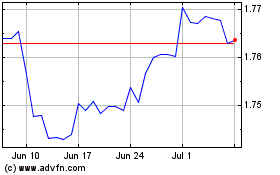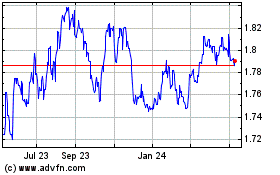Commodity Currencies Extend Slide
March 30 2015 - 1:28AM
RTTF2
Commodity currencies such as the Australian, the New Zealand and
the Canadian dollars continued to be weaker against their major
currencies in the Asian session on Monday, hurt by talks between
Iran and six world powers on lifting of sanctions that could add
more oil to the market. Crude oil for May delivery is currently
down $0.21 to $48.635 a barrel.
Foreign ministers of the six world powers - the U.S., China,
Russia, Germany, France and Britain - and Iran meet for the second
day today in Switzerland to reach a deal over sanctions and the
country's nuclear activities.
The Organisation of Petroleum Exporting Countries resisted calls
to cut output in order to maintain market share, which also weighed
on oil prices.
Speculation that concerns over the Yemen military operations may
be overdone also dampened sentiment.
Meanwhile, the decline in prices of copper and iron ore also
weighed on the commodity currencies.
In a speech at a San Francisco Fed conference on Friday, Federal
Reserve chief Janet Yellen said an interest rate hike may well be
warranted later this year but stressed that any increase in
interest rates would be gradual.
Amid uncertainties concerning the U.S. monetary policy and
economic outlook, the AUD, NZD and CAD has been trading lower in
recent sessions.
Friday, the commodity currencies fell against their major
rivals. The Australian dollar fell 1.04 percent against the U.S.
dollar, 1.11 percent against the yen and 0.22 percent against the
euro. The NZ dollar fell 0.39 percent against the U.S. dollar. The
Canadian dollar fell 1.06 percent against the U.S. dollar, 1.12
percent against the yen and 0.20 percent against the euro.
In the Asian trading today, the Australian dollar fell to near a
3-week low of 91.93 against the yen and near a 2-week low of 0.7711
against the U.S. dollar, from Friday's closing quotes of 92.25 and
0.7745, respectively. If the aussie extends its downtrend, it is
likely to find support around 91.10 against the yen and 0.75
against the greenback.
Against the euro, the aussie edged down to 1.4094 from last
week's closing quote of 1.4042. On the downside, 1.43 is seen as
the next support level for the aussie.
The NZ dollar also fell to near 2-week lows of 0.7524 against
the U.S. dollar and 89.72 against the yen in the Asian trading
today, from last week's closing quotes of 0.7561 and 90.06,
respectively. If the kiwi extends its downtrend, it is likely to
find support around 0.72 against the greenback and 86.90 against
the yen.
Against the euro, the kiwi edged down to 1.4443 from Friday's
closing value of 1.4384. The kiwi is likely to find support around
the 1.47 area.
The Canadian dollar also dropped to near a 2-week low of 1.2629
against the U.S. dollar, from Friday's closing value of 1.2612. If
the loonie extends its downtrend, it is likely to find support
around the 1.28 area.
Pulling away from early highs of 94.66 against the yen and
1.3706 against the euro, the loonie edged down to 94.40 and 1.3733,
respectively. The loonie may test support near 92.80 against the
yen and 1.40 against the euro.
Looking ahead, Swiss KOF leading indicator index for March, U.K.
mortgage approvals and M4 money supply data - both for February and
Eurozone business climate index for March are due to be
released.
In the New York session, preliminary German consumer price index
for March, Canada industrial product price and raw materials price
index - both for February and U.S. personal income and spending
data and pending home sales data for February are slated for
release.
At 9:00 am ET, European Union's financial affairs chief Pierre
Moscovici is expected to speak to the EU parliament committee in
Brussels.
Euro vs NZD (FX:EURNZD)
Forex Chart
From Mar 2024 to Apr 2024

Euro vs NZD (FX:EURNZD)
Forex Chart
From Apr 2023 to Apr 2024
